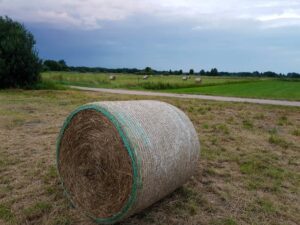Baling twine is a sturdy, environmentally friendly solution. Used in multiple applications ranging from packaging cattle feed bales to making animal halters for their livestock, it has many uses that are sure to prove useful for farmers and ranchers.
Anyone who works with horses understands the perils of tangled baling twine. Even one piece can be enough to kill an animal and is also hazardous for machinery.
It is a good choice for hay baling
Baling twine is both durable and biodegradable, helping reduce landfill waste or sewer blockages. Furthermore, its cost effectiveness and non-rust/rot resistance makes it a smart choice for farmers looking to make bales of hay or straw bales. Many producers choose baling twine for this task.
 If you plan to store your bales outside, select twine that has been treated with UV stabilizers to protect it from sunlight damage and prevent mold growth. Furthermore, UV-treated twine will outlive non-UV treated varieties by far.
If you plan to store your bales outside, select twine that has been treated with UV stabilizers to protect it from sunlight damage and prevent mold growth. Furthermore, UV-treated twine will outlive non-UV treated varieties by far.
Net wrap can provide an effective alternative to twine for tightening bales more securely and minimising hay loss. According to research conducted by the American Society of Agricultural and Biological Engineers, netwrapped bales held their shape and quality better than twined ones; additionally, netwrapping helps retain moisture for an abundant crop of high-quality hay.
Polypropylene twine, specifically made for baling hay and fibrous materials, can also be a viable choice. It is both stronger and cheaper than sisal twine; moreover it can withstand more pressure without becoming damaged over time. In addition, cleaning it is much simpler since there won’t be any rusting or rotting issues; you can find different sizes and strengths available; most made-in-USA options guarantee at least so many feet per carton.
It is environmentally friendly
Baling twine is an eco-friendly choice due to being made from natural materials and rapidly biodegrading when exposed to sunlight, without polluting or polluting wildlife or damaging equipment – an attractive feature for farmers looking to reduce their environmental footprint.
Baling twine is also recyclable, meaning that it won’t add to landfill waste or clog sewers and offers an economical alternative to other products. Useful for many tasks ranging from tying plants or fixing fences to keeping pests away, it can help create an eco-friendly garden experience!
Baling twine is typically composed of sisal or jute, and comes in multiple sizes and colours to meet any baler type and crop – for instance blue baling twine may be appropriate in less challenging situations while brown is better suited to more strenuous applications.
Baling twine is most often used to secure round hay bales together, but its versatility has other uses as well. Horse owners, for instance, often utilise baling twine for other applications – hanging ribbons at horse shows, loop blankets over barred stalls, hook Show Sheen fly spray and Show Sheen in easy access areas, as well as prevent pests from building nests within bales. Additionally, pesticide spray may prevent nests being built upon.
It is a good investment
Baling twine is an invaluable investment for farmers as it lasts longer than traditional twine. Plus, its stronger material allows it to bear more weight. Furthermore, being biodegradable means, it won’t contribute landfill waste or clog sewers; plus it keeps bales dry and reduces their chance of wetting out faster!
Care should be taken when disposing of twine, to avoid harming wildlife. Improper disposal could create trip hazards and entangle machinery; furthermore, soil contamination from used twine may damage ecosystems as well as pose a fire hazard risk.
Baling twine is an economical choice that can be reused again and again, saving money over time. Reusability makes baling twine an attractive investment option when used to repair items; additionally, its flexibility also makes it perfect for creating crafts such as doormats and rugs – just remember to wash it after every use for optimal results.
The report offers an in-depth study of the global Synthetic Baling Twine market. It offers an analysis of top competitors, their size and share as well as any opportunities or challenges within this industry. Furthermore, this forecast extends up to 2030; additionally the report contains detailed competitive territory information including supplier details information as well as investments made, alliances formed and other important business details of top players within this global industry.
It is a good choice for farmers
Farming communities always need plenty of baling twine in their vehicles – it’s essential. You can use it for multiple tasks ranging from tying hay bales together and binding feed for sheep, to creating baskets. Baling twine is also an invaluable conservation tool; an estimated 10% of young Osprey chicks die each year due to becoming entangled with baling twine.
Clean up your twine to help preserve Osprey populations! Most twine ends up in landfills or piles on landowners’ properties (where it can gum up machinery or be eaten by livestock and cattle, leading to digestive issues and death) or is burned, producing toxic fumes.
The ideal baling twine comes in various lengths and widths to meet your individual needs. Optimum tensile strength should allow it to handle high press density without failing. UV protection, windable convenience are other features you should look out for when selecting baler twine as part of its features.
Not just suitable for farmers, baler twine is also an invaluable item in the home. It can be used to craft braided baskets – perfect for planting fruit and vegetables – as well as weave into lead ropes for livestock or lunge lines, tie gates closed securely or provide solutions when there’s broken bolt or mishung gate.